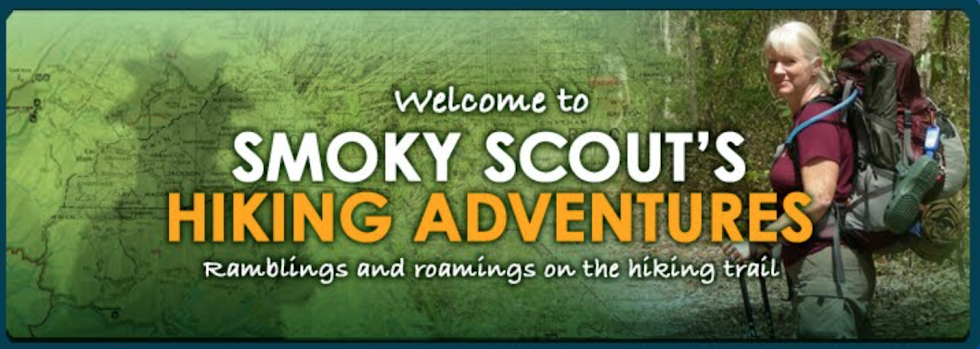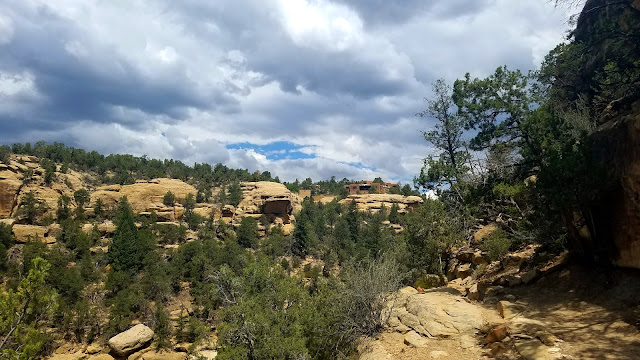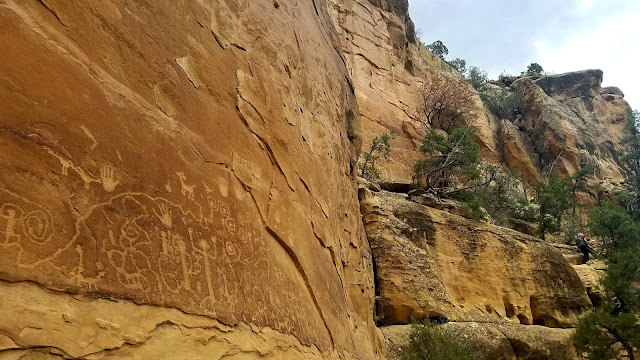Colorado 2022: Mesa Verde National Park – Cliff Palace & Petroglyph Point Trail
8/10/22 – 3 miles
As Jim and I planned our Colorado trip in 2022, Mesa Verde NP was undergoing extensive preservation work on some of its signature features, and we timed our August visit with the resumption of ranger-led tours for sites such as Balcony House and Cliff Palace. (Some sites were still closed.) Looking at the matrix of tour times and driving distances, we chose quality over quantity and booked only a tour of the Park’s centerpiece: Cliff Palace. Even so, I didn’t time the bookings quite right and ended up with one ticket at 10am and one at 10:30am (shrug).
[If you’re going: Cliff Palace can be viewed from an overlook without purchasing a ticket.]
It’s a long drive from Cortez to the Park entrance and then to the tour meeting place on Chapin Mesa, but my time-obsessed-self ensured that we were quite early. My time-obsessed-self’s twin sister rule-follower-self watched judgmentally as a family showed up and tried to tag onto the 10am tour. (They were successful because of no-shows.) Jim could have asked, too, and joined with me. Perhaps…he was happy to be in a separate group of his own?
Lesson learned: ask if you can tag in.
From this NPS website: “Sometime during the late 1190s, after primarily living on the mesa tops for 600 years, many Ancestral Pueblo people began moving into pueblos they built into natural cliff alcoves. The structures ranged in size from one-room granaries to villages of more than 150 rooms. While still farming the mesa tops, they lived in cliff dwellings, repairing, remodeling, and constructing new rooms for nearly a century.”
Cliff Palace is a cliff dwelling that has existed for over 700 years, but its “discovery” in 1888 accelerated the deterioration of this extraordinary site. Read more here about ongoing preservation work at Mesa Verde NP.
The tour begins by descending a ladder on the left side and moves through the site. It ends by climbing three ladders at the far right, so groups don’t pass each other. Archeological studies conclude that the site contained 150 rooms and supported a population of about 100 people.
Our guide, Ranger Lou Ann, was passionate, knowledgeable, and respectful of the indigenous peoples that lived in cliff dwellings. Her descriptions brought them to life living in community, cooking fires, everyday chores, caring for their children. She explained that although Cliff Palace was built with the intention to live there indefinitely, after about 90 years their population had increased to a point that there was not enough space or reliable water to sustain the community.
The website continues: “In the mid-1200s, the population began migrating to the south, into present-day New Mexico and Arizona. By the end of the 1200s, most everyone had migrated away.”
Kivas are primarily round, underground rooms used for both routine purposes and special ceremonies. There are 23 kivas at Cliff Palace (not all visible on the tour). Read more about kivas here.
The tour seemed to be over in minutes – did I miss something? Fortunately, the website has numerous links to photos and information to learn more. As I climbed the three ladders back to the top of the mesa, I was out of breath. [MEVE is at 8,000 feet elevation.]
Quality over quantity, remember? Instead of driving on to the farthest corners of the park at Wetherill Mesa, Jim and I opted to follow the advice from yesterday and hike nearby Petroglyph Point Trail. It starts near the Chapin Mesa Archeological Museum (closed during our visit) and Spruce Tree House.
We hiked the 2.4-mile loop trail counterclockwise, joining Spruce Canyon Trail for a short distance, then departing from it to hug the wall of Chapin Mesa below the rim. The first third of a mile was a very rocky, bouldering type trail of intriguing rock formations and overhangs – lots of fun! We left the crowds behind.

 A small cliff dwelling, possibly home to one or two families – notice the soot from cooking fires
A small cliff dwelling, possibly home to one or two families – notice the soot from cooking fireson the back wall and ceiling
At about 1.4 miles, the petroglyph appears on a rock wall that can be easily missed if you’re busy watching your footing. From the website: “(It) represents the written language of the people who inhabited and traveled through this canyon. More than thirty human and animal figures, spirals, and handprints cover an area of over 35 feet wide.” Read more about the petroglyph here.
Similar to the Point Lookout Trail we hiked yesterday, the top flattens out with wide areas at the edges to look down into the canyons. It was now midafternoon, fully exposed and very hot, and we were ready to close the loop.
Satisfied with our adventures for today, we drove out of the park (another hour) back to our home base with time to visit the Cortez Cultural Center. It’s a community arts center featuring artifacts and exhibits of Native American and Western handicrafts, art, music and history. A staff person invited us to come back at 7pm for a demonstration of Native American dance.
for the beer and creative taps
At the Cultural Center’s outdoor amphitheater, 30 or 40 people were gathered on concrete steps for the dance demonstration. Half a dozen men and women played drum beats as two adult women and several children of varying ages performed dances. The dancers wore intricate costumes of beading, shells and bells.
Between dances the narrator explained their stories and purposes. Everyone in the ensemble was his child or grandchild, and as the patriarch he has taken on the task of keeping the traditions alive for his people. The event ended with a group dance with audience participation. I’m so glad we had the opportunity for this! It left me wanting to explore more in this corner of Colorado.
where or how far I have moved my feet
but how I am moved in my heart."




















.jpeg)




.jpeg)






.jpeg)
No comments:
Post a Comment